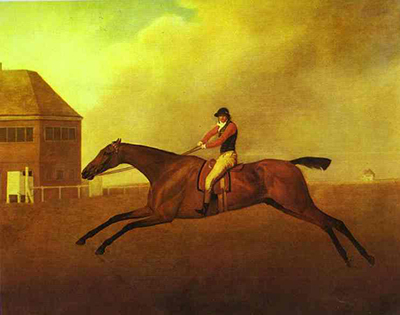The Baronet adds to Stubbs’ pieces of art that he created to adorn the racing success of horses.
This piece was expertly developed to exemplify a celebrated racing horse called Baronet. Lord Sherborne bred it, and it was born in 1785. Sir Walter Vavasour then bought colt and later sold it to the Prince of Wales. The horse began racing in 1789 but its best year was in 1791 when it won the competitive Oatland Stakes. This print shows The Prince of Wale’s jockey, Samuel Chifney on its back.
Stubbs goes to great lengths to integrate the character and style of the celebrated jockey and horse in this print. He shows off the royal colours worn by the jockey and golden frogging he is holding with his head turned to the spectators. His ability to showcase the horse’s legs off the ground is a bold and excellent example of his attention to detail. The paint lies against a backdrop of the Newmarket Heath. Though the market appears empty, Stubbs brings out the effects of the race, which take long to disappear.
Despite the great skill that Stubbs shows in creating this painting, he received little training. However, he used a relatively conventional painting technique when developing this print with an unusually high level of skill. He used liquid paint to create the subject on the canvas. Stubbs then builds on the detail of the print using lighter shades and adds a bolder element of light to the subject before developing the rest of the paint. The accuracy of detail in developing the racing horse and Samuel Chifney, the jockey, is likely to trigger the question- Who is the real champion here, the horse or its rider? The artist then finished the painting using a fluorescing medium across the print to help keep the paint in good condition. Stubbs adopted this finishing technique on most of his artwork, which explains why his prints don’t need restoration.
The Baronet is among the Royal Collection created by George Stubbs. According to history, they were all acquired by George IV and sent to the King’s Lodge from Carlton House in 1822 to showcase sports paintings. Prior the purchase, Thomas Allwood is said to have presented a bill worth £110 to the Prince for carving and gilding eight frames that measure 40x50 inches for all the pictures painted by Mr Stubbs. The Baronet was one of the paintings in that collection as it was created during that period.




